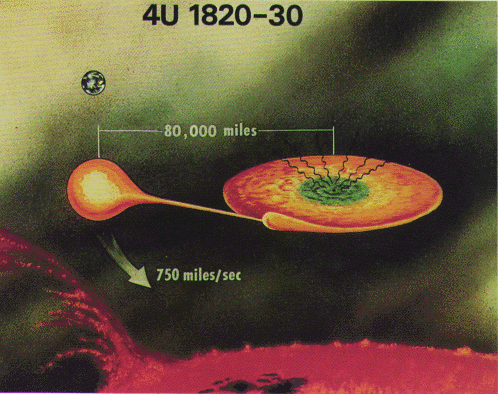Imagine the Universe News - 21 November 2000
Three Hours of Unimaginable Neutron Star Fury
| 21 November 2000 |
As if daily billion-degree, helium-fueled nuclear explosions on neutron stars releasing more energy in 10 seconds than the Sun does in a week weren't fantastic enough, brace yourself for one blast far more powerful and lasting far longer.
Dr. Tod Strohmayer of NASA Goddard Space Flight Center observed a three-hour burst spouting gushers of gaseous metals from deep below a dense sea of helium plasma. This magnificent event lasted a thousand times longer than just about any burst ever observed on a neutron star.
Also, the burst was likely caused by over a year's worth of stored carbon -- the nuclear ash from daily helium explosions -- packed so tightly below the neutron star surface that it finally fused and exploded. This, in fact, marks the first observation of a carbon-fueled thermonuclear explosion on a neutron star.
"This was quite a find," said Strohmayer, who presented his findings this week at the meeting of the High Energy Astrophysics Division of the American Astronomical Society in Honolulu, Hawaii. "We had suspected that such an explosion could exist; but because they are so rare, we didn't know if we could actually observe one." Strohmayer did indeed observe one, and his tool was NASA's Rossi X-ray Timing Explorer, an X-ray satellite.
This neutron star, in a binary star system called 4U 1820-30, is not visible at all except when it flares up in X-ray light. So such a long burst provides an extended view of the neutron star, particularly of what is happening underneath the surface, said Strohmayer.

Typical neutron star bursts last about 10 seconds, a thousand times shorter and 500-1,000 times less energetic than this burst in 4U 1820-30. The three-hour burst released 20 times more energy than the Sun does in a year.
The neutron star in 4U 1820-30 is in tight orbit with a low-mass dwarf star composed of mostly helium. Their orbital period of 11 minutes is the shortest known of any binary system. In fact, the stars are so close that the orbit would easily fit inside the Sun. The neutron star's strong gravitational field attracts gas from the companion star. This gas eventually rains down upon the surface of a neutron star, a journey visible in many forms of light, particularly X rays.
When enough gas builds up on the neutron star surface -- in this case, helium gas -- the increased pressure raises the temperature and initiates helium fusion, a nuclear reaction that manifests itself as an X-ray burst. X-ray bursts often erupt on neutron stars in binary systems several times a day, and they are often fueled by helium fusion.
Strohmayer said an "ordinary" burst may have triggered the much longer one. The data reveal that there was a burst that lasted about 10 seconds before fading. Then, a few seconds later, the longer burst ignited... and kept on going. The three-hour nuclear inferno was likely fueled by carbon, the ashes of helium fusion.
Over the course of a year or two, more and more helium rains down upon the neutron star. This helium ignites and produces carbon. The carbon ash builds up under layers of new helium and other gaseous metals. When enough carbon builds up -- and the pressure raises the temperature to many times that of our Sun's core -- carbon will begin to fuse.
Strohmayer estimated that it would take about a billion trillion pounds of carbon and a temperature of a billion degrees to create the three-hour explosion on this particular neutron star. At the rate at which material is crashing down on the star's surface, Strohmayer estimated that it would take about 1 to 2 years for that much carbon to build up. The amount of carbon consumed in the explosion was about mass of Pluto or 1/10th the total mass of the Moon.
So this carbon burst is not only something to write home about, it is also something that could power your home: an energy release 1,000 trillion times greater than the entire United States energy consumption used in 1999. All from a 7-mile-wide ember 20,000 light years away.

